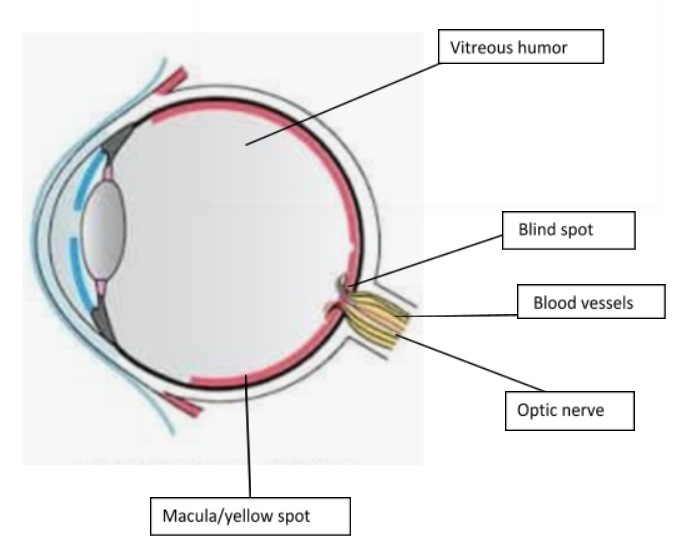
The point in the eye of mammals from which optic nerves and blood vessels leave the eyeball is called –
A. Yellow spot
B. Blindspot
C. Pars optica
D. Green spot
Answer
577.5k+ views
Hint: : No image formation takes place at this point due to absence of photoreceptors. The other name for this spot is optic nerve head.
Complete answer:

From the above diagram, we can visualize that yellow spot also known as the macula.
1. It is the functional center of an eye and also the place of sharpest sight.
2. The yellow color of the macula is due to its content of lutein and zeaxanthin.
3. Both of them are yellow xanthophyll carotenoids, which is derived from the diet.
4. Macula has the ability to absorb the excess of blue and ultraviolet radiation, entering the eye and thus acts as a natural sunblock in this part of the retina.
5. Blindspot is a small portion of the visual field of the eye. It corresponds to the position of the optic disk in the retina. It lacks photoreceptors, i.e., no rods and cones are present here. 6. So, no image detection is possible.
From this diagram, it is clearly visible that the blind spot is the point where blood vessels and the optic nerve are leaving the eyeball.
So, the correct option is B.
Note: There is a close relationship between eyes and the liver. Our ability to see depends mainly on the nourishment of our eyes, which comes from the blood that is stored in the liver. So, any disorder in the liver will be reflected in our vision.
Complete answer:

From the above diagram, we can visualize that yellow spot also known as the macula.
1. It is the functional center of an eye and also the place of sharpest sight.
2. The yellow color of the macula is due to its content of lutein and zeaxanthin.
3. Both of them are yellow xanthophyll carotenoids, which is derived from the diet.
4. Macula has the ability to absorb the excess of blue and ultraviolet radiation, entering the eye and thus acts as a natural sunblock in this part of the retina.
5. Blindspot is a small portion of the visual field of the eye. It corresponds to the position of the optic disk in the retina. It lacks photoreceptors, i.e., no rods and cones are present here. 6. So, no image detection is possible.
From this diagram, it is clearly visible that the blind spot is the point where blood vessels and the optic nerve are leaving the eyeball.
So, the correct option is B.
Note: There is a close relationship between eyes and the liver. Our ability to see depends mainly on the nourishment of our eyes, which comes from the blood that is stored in the liver. So, any disorder in the liver will be reflected in our vision.
Recently Updated Pages
Two men on either side of the cliff 90m height observe class 10 maths CBSE

What happens to glucose which enters nephron along class 10 biology CBSE

Cutting of the Chinese melon means A The business and class 10 social science CBSE

Write a dialogue with at least ten utterances between class 10 english CBSE

Show an aquatic food chain using the following organisms class 10 biology CBSE

A circle is inscribed in an equilateral triangle and class 10 maths CBSE

Trending doubts
The shortest day of the year in India

Why is there a time difference of about 5 hours between class 10 social science CBSE

Write a letter to the principal requesting him to grant class 10 english CBSE

What is the median of the first 10 natural numbers class 10 maths CBSE

The Equation xxx + 2 is Satisfied when x is Equal to Class 10 Maths

What is the missing number in the sequence 259142027 class 10 maths CBSE




